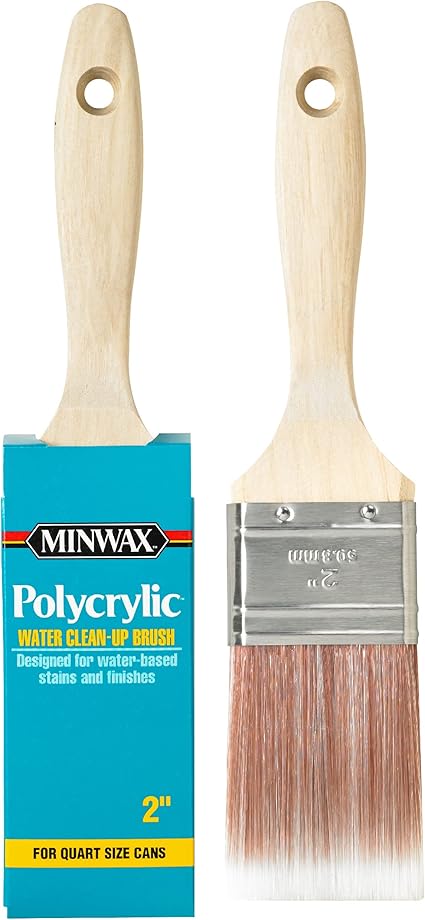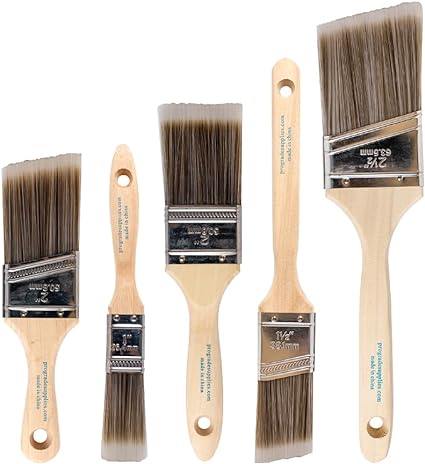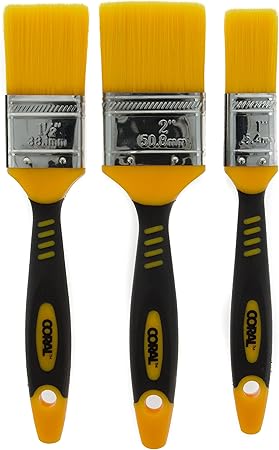Are you confused to select the best brush to use while applying polyacrylic to your wood projects? Popular transparent finish Polycrylic both maintains and improves the appeal of wood surfaces.
How to Choose the Right Brush for Polycrylic?
1. Bristle Type: It’s a great option for applying polyacrylic. Water-based finishes are more suited for synthetic bristles, which typically consist of nylon or polyester than for polyacrylic, which is also water-based material. Due to their lack of water absorption, it will decrease swelling and provide a smooth application, in contrast to natural bristles.
2. Brush Size: The brush size has to match the requirements of the current work. A bigger brush (2.5 to 3 inches) works best on larger surfaces (such as tabletops or cabinets) since it covers more area more rapidly. A thinner brush (one to one and a half inches) provides better control for smaller tasks or precise work.
3. Bristle Quality: A smoother finish can be achieved with higher-quality bristles. Seek choose brushes; s with shape-holding, soft, flexible bristles.
4. Brush ShapeA flat brush is generally preferred for polycrylic as it allows for even application of the finish. Angled brushes are better for reaching tight corners or edges. Depending on the project, you may want to have both types on hand.
5. Handle Comfort: It takes time to apply polyacrylic, especially on large projects, therefore it’s important to use a brush with a comfortable handle. You’ll be happier after a while if the handle fits comfortably in your hands.
6. Bristle Length: Because longer bristles let the brush hold more finish and distribute it more evenly, contributes to a smoother application. But, short bristles work better for control and accuracy.
7. Cleaning and Maintenance: Selecting a brush that is easy to maintain and won’t lose its quality after several uses is still vital, even though polyacrylic is water-based and makes cleaning the brush afterward simple. In the long run, brushes that are easy to clean and dry without losing their shape will perform better.
Top Brushes for Polyacrylic
1. Purdy XL Series Brush
A premium synthetic bristle brush that works great for applying polyacrylic is the Purdy XL Series Brush. While it works well with water-based finishes like polyacrylic, its adaptable nature allows it to be used with both oil- and water-based finishes.

Key Features:
- Synthetic bristles are made from a blend of nylon and polyester.
- Available in various sizes, from 1 inch to 3 inches.
- Comfortable grip handle for extended use.
- Durable construction with long-lasting bristles.
- Smooth, even application without leaving streaks.
Pros:
- Excellent for water-based finishes.
- Long-lasting bristles that maintain shape.
- Smooth application with minimal brush marks.
- Easy to clean.
Cons:
- Slightly more expensive than other options.
- May be too large for very detailed work (depending on size).
Best For:
Woodworkers and DIYers looking for a reliable, high-quality brush for applying polyacrylic on medium to large surfaces.
2. Wooster Silver Tip Brush
The Wooster Silver Tip Brush is another great option for applying polycrylic. It is designed with fine-tipped, soft bristles that provide a smooth and even finish, making it a favorite for both professional and home projects.

Key Features:
- Soft, fine-tipped polyester bristles.
- Available in sizes from 1 inch to 3 inches.
- Lightweight and easy to handle.
- Ideal for applying water-based finishes like polyacrylic.
- Excellent control for detailed applications.
Pros:
- Smooth, streak-free finish.
- Lightweight and easy to maneuver.
- Perfect for detailed work and smaller surfaces.
- Affordable and long-lasting.
Cons:
- Bristles may be too soft for thicker finishes.
- Not as durable as some higher-end brushes.
Best For:
DIYers and professionals who need a smooth, streak-free finish on small to medium projects.
3. Minwax Polycrylic Brush
Different types of brushes made especially for use with Minwax’s polyacrylic finishes is available. With synthetic bristles, the Minwax Polycrylic Brush is made to minimize brush marks and provide an even application.

Key Features:
- Synthetic bristles are made from high-quality nylon.
- Designed specifically for water-based finishes.
- Available in various sizes for different project needs.
- Comfortable grip for long periods of use.
- Ideal for smooth, streak-free applications.
Pros:
- Perfect for applying polyacrylic finishes.
- Reduces brush marks and leaves a smooth finish.
- Easy to clean.
- Available in a range of sizes.
Cons:
- Only designed for water-based finishes.
- May wear out faster with repeated heavy use.
Best For:
Those using Minwax polyacrylic or other water-based finishes who want a brush specifically designed for that purpose.
4. Wooster Softip Brush
The Wooster Softip Brush is designed for precision and control, making it ideal for small projects or detailed work. Its soft synthetic bristles are perfect for polyacrylic application, providing a smooth finish without leaving streaks.

Key Features:
- Soft synthetic bristles for even application.
- Available in various sizes.
- Lightweight and comfortable to use.
- Suitable for both small and large projects.
- Easy to clean after use.
Pros:
- Excellent for small and detailed projects.
- Soft bristles reduce brush marks.
- Affordable and widely available.
- Great control and precision.
Cons:
- Not as durable for heavy-duty use.
- Smaller sizes may not be ideal for large surfaces
Best For:
Woodworkers and DIYers working on small, detailed projects or areas where precision is key.
5. Pro Grade Paint Brush Set
The Pro Grade Paint Brush Set is a wonderful alternative if you’re on a tight budget yet want quality results. This kit is adaptable for a wide range of applications because it comes with different types of brush sizes. The synthetic bristles provide smooth results at a reasonable cost if used with water-based finishes like polyacrylic.

Key Features:
- The set includes various brush sizes for different tasks.
- Synthetic bristles are best for water-based finishes.
- Comfortable handles for easy grip.
- Easy to clean and maintain.
- Suitable for both beginners and experienced users.
Pros:
- Budget-friendly.
- Variety of sizes in one set.
- Smooth application with minimal brush marks.
- Comfortable to use.
Cons:
- Not as durable as higher-end brushes.
- May shed bristles after extended use.
Best For:
DIYers looking for an affordable brush set that can handle different project sizes and types.
6. Coral Zero-Loss Paintbrush
The Coral Zero-Loss Paintbrush is made to stop bristle shedding, ensuring a professional, polished finish. This brush is well-known for its longevity and user-friendliness, and it performs excellently with water-based finishes like polyacrylic.

Key Features:
- Synthetic bristles are designed to prevent shedding.
- Available in various sizes.
- Smooth application without bristle loss.
- Comfortable handle for extended use.
- Works well with polyacrylic and other water-based finishes.
Pros:
- No bristle loss, ensuring a clean finish.
- Durable and long-lasting.
- Easy to clean and maintain.
- Smooth, streak-free results.
Cons:
- Slightly stiffer bristles compared to other brushes
- May not be ideal for very detailed work
Best For:
Professionals and DIYers who want a durable brush that prevents bristle shedding and provides a smooth finish on larger surfaces.
FAQ
1. What brush size should I use for polyacrylic?
A larger brush (2.5 to 3 inches) works best on larger surfaces like tabletops or cabinets. A thinner brush (1 to 1.5 inches) enables more control and precision for smaller jobs or delicate work.
2. Can I use a natural bristle brush for polyacrylic?
Natural bristle brushes tend to absorb water, swell, and cause streaks, thus using them with polyacrylic is not advised. This water-based finish works well with synthetic brushes.
3. How do I prevent brush marks before applying polyacrylic?
Brush marks can be reduced by using soft, flexible bristles, thin coats, and high-quality synthetic brushes. Sanding lightly between coats also helps achieve a smoother finish.
4. How do I clean a brush after applying polyacrylic?
Because polyacrylic is a water-based paint, brush washing is easy. Once the finish has been removed, thoroughly rinse the brush with clean water and let it dry. Afterward, rinse the brush with warm, soapy water.
